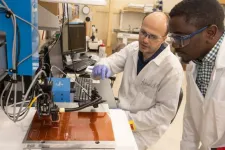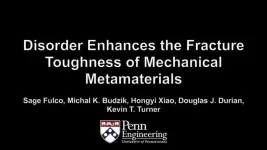(Press-News.org) EMBARGOED PRESS RELEASE: MONDAY 17 FEBRUARY 2025 3:00PM U.S. EASTERN TIME (8:00PM GMT)
Animals are not just inhabitants of the natural world—they are its architects. A new study led by Professor Gemma Harvey from Queen Mary University of London has revealed how hundreds of species shape the landscapes we depend on, from vast termite mounds visible from space to hippos carving drainage systems and beavers creating entire wetlands.
Published in Proceedings of the National Academy of Sciences (PNAS), this first-of-its-kind global synthesis identifies 603 species, genera, or families that influence Earth’s surface processes. From tiny ants shifting soil to salmon reshaping riverbeds, the study highlights the diversity and scale of animals’ impact across all freshwater and terrestrial ecosystems.
By estimating the collective energy of these “natural engineers,” the research shows that their geomorphic contributions rival those of hundreds of thousands of major floods.
Key Insights from the Study:
Unexpected Diversity: Beyond iconic examples like beavers and salmon, the study identifies hundreds of species—including insects, mammals, fish, birds, and reptiles—that shape landscapes in remarkable ways.
Freshwater Ecosystems in Focus: Despite covering just 2.4% of the planet’s surface, freshwater habitats host over a third of these remarkable species.
Impressive Energy Output: Animals collectively contribute at least 76,000 gigajoules of energy annually to shaping the Earth’s surface—a figure comparable to hundreds of thousands of extreme floods. This estimate is likely conservative, as significant knowledge gaps exist, particularly in tropical and subtropical regions where biodiversity is highest but research is limited.
Fascinating Examples: Termites build vast networks of mounds in Brazil, some covering thousands of square kilometres, while salmon spawning can shift as much sediment as annual flooding. Even ants, through their tiny but countless actions, alter soil structure and drainage.
Professor Harvey explains:
"This research shows that the role of animals in shaping Earth’s landscapes is much more significant that previously recognised. From beavers creating wetlands to ants building mounds of soil, these diverse natural processes are crucial, yet we risk losing them as biodiversity declines."
Nearly 30% of the identified species are rare, endemic, or threatened, meaning vital geomorphic processes could cease before their full significance is understood. This loss could have profound consequences for ecosystems and the landscapes they support.
Looking Ahead:
This research provides new insights for biodiversity conservation and ecosystem restoration. Rewilding and species reintroduction projects, such as the reintroduction of beavers to restore wetlands, show how harnessing these natural processes could help combat environmental challenges like erosion and flooding.
-END-
Notes to Editors:
The article ‘Global diversity and energy of animals shaping the Earth’s surface’ is under PNAS embargo until Monday, Feb. 17 at 3 pm US ET. It is scheduled to publish on Tuesday, Feb. 18 due to the holiday in the US.
PNAS provides journalists with access to content through EurekAlert!: https://www.eurekalert.org/news-releases/1073420
After this article publishes, it will be available at: https://www.pnas.org/cgi/doi/10.1073/pnas.2415104122
‘Global diversity and energy of animals shaping the Earth’s surface’
Authors: Gemma L. Harvey1*, Zareena Khan1, Lindsey K. Albertson2, Martin Coombes3, Matthew F. Johnson4, Stephen P. Rice5, Heather A. Viles3
Affiliations: 1. School of Geography; Queen Mary University of London, London, UK. | 2. Department of Ecology, Montana State University, USA.| 3.School of Geography and the Environment, University of Oxford, UK. | 4. School of Geography, University of Nottingham, UK. | 5. Department of Natural Sciences, Manchester Metropolitan University, UK.
High-resolution images and examples of animal-driven landscape changes, including beaver dams, ant mounds, salmon redds, are available upon request.
For media enquiries or to arrange interviews with Professor Gemma Harvey, please contact James Cleeton, Faculty Communications Officer, at j.cleeton@qmul.ac.uk.
About Queen Mary University of London
At Queen Mary University of London, we believe that a diversity of ideas helps us achieve the previously unthinkable. Throughout our history, we’ve fostered social justice and improved lives through academic excellence – and we continue to live and breathe this spirit today, not because it’s simply ‘the right thing to do’ but for what it helps us achieve and the intellectual brilliance it delivers.
A member of the prestigious Russell Group, Queen Mary is a research-intensive university that connects minds worldwide. We work across the humanities and social sciences, medicine and dentistry, and science and engineering, with inspirational teaching directly informed by our world-leading research.
Our distinctive history stretching back to 1785 is built on four historic institutions (the London Hospital Medical College, St Bartholomew’s Medical College, Westfield College and Queen Mary College) with a shared vision to provide hope and opportunity for the less privileged or otherwise under-represented. Today, we remain true to that belief in opening the doors of opportunity for anyone with the potential to succeed and helping to build a future we can all be proud of.
Visit qmul.ac.uk to find out more.
END
PROVIDENCE, R.I. [Brown University] — The causes of obesity are complex and influenced by many factors. While research has highlighted connections between sleep, eating patterns and weight gain, scientists remain uncertain of the role of the circadian system — the biological clock — in shaping eating patterns.
But a new study from researchers at the Warren Alpert Medical School of Brown University and Mass General Brigham reveals a distinct relationship between circadian rhythms, weight and eating habits in adolescents, a vulnerable age group whose eating patterns influence their lifelong ...
February 17, 2025 – Less than one in five patients are tested for cardiovascular risk factors following pregnancy-related hypertension or diabetes, according to a new study published in the "Go Red for Women" issue of Circulation.
Cardiovascular diseases are a leading cause of death among women. People who develop hypertensive disorders of pregnancy or gestational diabetes are at a higher risk of experiencing a future stroke or heart disease. Screening for high blood pressure, lipids, and sugars plays a crucial role in the early diagnosis of risk factors for cardiovascular disease.
"There's increasing ...
A new study, published in JAMA Internal Medicine and led by researchers from the University of California San Diego Qualcomm Institute and School of Medicine, reveals a dramatic increase in sports betting and gambling addiction help-seeking since the landmark Murphy v. NCAA Supreme Court decision in 2018 paved the way for states to legalize sports betting.
“When the Supreme Court legalized sportsbooks — a venue where people can wager on various sports competitions — in Murphy v. NCAA, public health experts paid little attention,” said the study’s senior author John W. Ayers, Ph.D., who is vice chief of innovation in the ...
Artificial intelligence (AI) can rapidly screen patients for clinical trial enrollment, according to a new study published in JAMA and led by Mass General Brigham researchers. Their novel AI-assisted patient screening tool significantly improved the speed of determining eligibility and enrollment in a heart failure clinical trial compared to manual screening. These findings suggest that using AI can be cheaper than conventional methods and speed up the research process, which could mean patients get earlier access to proven, effective treatments.
“Seeing this AI capability accelerate screening and trial enrollment ...
Amyotrophic lateral sclerosis (ALS) is a fatal neurodegenerative disease with few treatment options. Since 2018, the Sean M. Healey & AMG Center for ALS at Massachusetts General Hospital (MGH), a founding member of the Mass General Brigham healthcare system, has been working with national and international stakeholders to accelerate ALS research by launching the first platform trial in ALS to simultaneously test multiple drugs using shared trial infrastructure and placebo data. Findings from the first four drugs evaluated through the trial are published ...
Pancreatic cancer is fueled by connections to the nervous system. This is reported by scientists from the German Cancer Research Center (DKFZ) and the Heidelberg Institute for Stem Cell Technology and Experimental Medicine (HI-STEM)* in their current publication in Nature. The team discovered that the tumor specifically reprograms the neurons for its own benefit. In mice, blocking nerve function inhibited cancer growth and increased the sensitivity of tumor cells to certain chemotherapies and immunotherapies.
For several years, ...
A nut used in herbal tea has become a hydrogel perfect for a variety of biomedical uses in new research from the University of Chicago Pritzker School of Engineering (UChicago PME) and UChicago Chemistry Department.
A paper published today in Matter created a malva nut hydrogel for medical uses ranging from wound care to ECG readings. The research doesn’t rely on the rumored health benefits of the nuts – in China, they’re known as the sore throat remedy Pangdahai (PDH) – but for their ability to swell in water.
“You never saw the fruit from a tree expand in that kind of volume,” said first ...
Sucrase-isomaltase (SI) is an intestinal enzyme critical for the digestion of dietary carbohydrates, particularly sucrose and starch. Previous studies from the Gastrointestinal Genetics team at CIC bioGUNE - BRTA and LUM University suggested a genetic link between SI defects and IBS, whereby certain DNA changes cause reduced enzymatic activity and inefficient digestion of carbohydrates, thus inducing symptoms like bloating, diarrhoea, and abdominal pain. As the name gives away, however, SI is a special case in that it encompasses two enzymes with different carbohydrate-digesting ...
BINGHAMTON, N.Y. -- Binghamton University maintains its status as an R1 institution for its prolific research activity, according to a new list from the Carnegie Classification of Institutions of Higher Education.
Every three years, the Carnegie Classification looks at schools’ research expenditures and graduate programs to evaluate which campuses can be considered an R1 institution for “very high spending and doctorate production.”
Schools with this designation must spend at least $50 million on research and development and award at least 70 research doctorates. Binghamton wrapped ...
Cut open a bone and you’ll see a subtly disordered structure. Tiny beams, called trabeculae, connect to one another in irregular patterns, distributing stress and lending bones an impressive toughness. What if human-made materials could exhibit similar properties?
In a new paper in Proceedings of the National Academy of Sciences Nexus, researchers at Penn Engineering, Penn Arts & Sciences and Aarhus University found that adding just the right amount of disorder to the structure of certain materials can make them more than twice as resistant to cracking.
The finding opens the door to more widespread use of so-called “mechanical metamaterials,” ...





